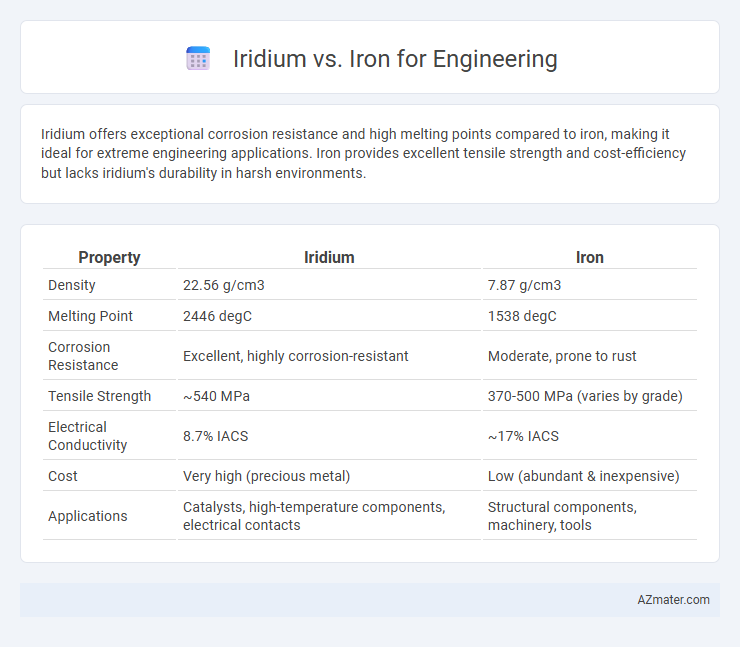Iridium offers exceptional corrosion resistance and high melting points compared to iron, making it ideal for extreme engineering applications. Iron provides excellent tensile strength and cost-efficiency but lacks iridium's durability in harsh environments.
Table of Comparison
| Property | Iridium | Iron |
|---|---|---|
| Density | 22.56 g/cm3 | 7.87 g/cm3 |
| Melting Point | 2446 degC | 1538 degC |
| Corrosion Resistance | Excellent, highly corrosion-resistant | Moderate, prone to rust |
| Tensile Strength | ~540 MPa | 370-500 MPa (varies by grade) |
| Electrical Conductivity | 8.7% IACS | ~17% IACS |
| Cost | Very high (precious metal) | Low (abundant & inexpensive) |
| Applications | Catalysts, high-temperature components, electrical contacts | Structural components, machinery, tools |
Introduction to Iridium and Iron in Engineering
Iridium and iron serve distinct roles in engineering due to their unique properties; iridium is a rare, dense metal known for its exceptional corrosion resistance and high melting point, making it ideal for high-temperature, harsh-environment applications such as aerospace and electronics. Iron, abundant and versatile, forms the basis of steel alloys that provide structural strength and cost-effective durability in construction, automotive, and machinery industries. Understanding the material characteristics and application-specific benefits of iridium and iron is crucial for selecting the appropriate metal in advanced engineering projects.
Chemical and Physical Properties Comparison
Iridium exhibits exceptional chemical inertness and corrosion resistance, with a melting point of 2,446degC, making it suitable for high-temperature and harsh chemical environments compared to iron, which has a melting point of 1,538degC and is more prone to oxidation and rust. Physically, iridium's density (22.56 g/cm3) far exceeds iron's (7.87 g/cm3), providing superior hardness and wear resistance crucial for durable engineering applications. The distinct differences in thermal conductivity and tensile strength between iridium and iron influence their selection in specialized alloys and high-performance mechanical components.
Strength and Durability: Iridium vs. Iron
Iridium exhibits exceptional strength and durability, surpassing iron in hardness and resistance to corrosion due to its dense atomic structure and high melting point of 2,446degC. Iron, while widely used in engineering for its malleability and cost-effectiveness, is susceptible to rust and structural fatigue under extreme conditions. The superior tensile strength and chemical inertness of iridium make it more suitable for specialized applications requiring long-term durability in harsh environments.
Corrosion Resistance and Longevity
Iridium exhibits exceptional corrosion resistance, outperforming iron significantly due to its high stability against oxidation and chemical attack, making it ideal for extreme and harsh environments in engineering applications. Iron, while widely used for its strength and affordability, is prone to rust and corrosion when exposed to moisture and oxygen, often requiring protective coatings to extend its lifespan. Engineers favor iridium components in situations demanding superior longevity and minimal maintenance, despite higher material costs.
Applications in Modern Engineering
Iridium's exceptional corrosion resistance and high melting point make it ideal for applications in aerospace engineering, catalytic converters, and electrical contacts, where durability under extreme conditions is critical. Iron's abundant availability, magnetic properties, and strength are fundamental in construction, automotive manufacturing, and heavy machinery, providing versatile support in structural frameworks and mechanical components. While iron remains indispensable for general engineering due to its cost-effectiveness and machinability, iridium's specialized use in high-performance and corrosive environments highlights its niche significance in modern engineering.
Cost and Availability Factors
Iridium, a rare and expensive platinum-group metal, significantly exceeds iron in cost due to its limited global supply and complex extraction processes, making it impractical for widespread engineering use. Iron, abundant and inexpensive, remains the primary material in construction and manufacturing industries because of its cost-effectiveness and ready availability. Engineering projects prioritize iron when balancing budget constraints and material accessibility, reserving iridium for specialized applications requiring exceptional corrosion resistance and high-temperature stability.
Machinability and Fabrication Challenges
Iridium exhibits exceptional corrosion resistance and high melting point but presents serious challenges in machinability due to its extreme hardness and brittleness, often requiring specialized cutting tools and slow machining speeds. Iron, particularly mild steel, offers superior machinability with standard tooling and predictable fabrication processes, making it more cost-effective and easier to weld, cut, and form. The fabrication of iridium components demands advanced techniques such as electro-discharge machining and precision grinding, while iron allows for conventional manufacturing methods, influencing material selection based on project complexity and budget constraints.
Environmental Impact and Sustainability
Iridium and iron differ significantly in environmental impact and sustainability for engineering applications. Iron, abundantly available and recyclable, offers a low-cost and eco-friendly material choice with established green manufacturing processes. Iridium, a rare and precious metal, involves energy-intensive extraction and limited recyclability, raising concerns about resource scarcity and environmental footprint despite its superior corrosion resistance and durability.
Performance in Extreme Conditions
Iridium exhibits exceptional corrosion resistance and maintains structural integrity at temperatures exceeding 2,400degC, outperforming iron, which oxidizes rapidly and weakens above 1,538degC. Its high density and melting point make iridium an ideal choice for aerospace and high-temperature engine components subjected to extreme thermal and mechanical stress. Iron, while more cost-effective and versatile, is prone to oxidation and embrittlement in harsh environments, limiting its use in applications requiring sustained performance under extreme conditions.
Choosing the Right Metal for Your Engineering Needs
Iridium offers exceptional corrosion resistance and high melting points, making it ideal for applications requiring durability under extreme temperatures and harsh chemical environments. Iron provides cost-effective strength and versatility, commonly used in construction and machinery where moderate corrosion resistance and machinability are sufficient. Selecting between iridium and iron depends on balancing performance requirements with budget constraints and environmental conditions specific to the engineering project.

Infographic: Iridium vs Iron for Engineering
 azmater.com
azmater.com